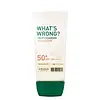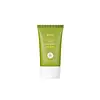What's inside
What's inside
 Key Ingredients
Key Ingredients

 Benefits
Benefits

 Concerns
Concerns

 Ingredients Side-by-side
Ingredients Side-by-side

Water
Skin ConditioningC12-15 Alkyl Benzoate
AntimicrobialEthylhexyl Methoxycinnamate
UV AbsorberCetyl Ethylhexanoate
EmollientMethylpropanediol
SolventGlycerin
HumectantDiethylamino Hydroxybenzoyl Hexyl Benzoate
UV FilterCetearyl Alcohol
EmollientNiacinamide
SmoothingTitanium Dioxide
Cosmetic Colorant1,2-Hexanediol
Skin ConditioningDipropylene Glycol
HumectantPolysorbate 60
EmulsifyingCetearyl Olivate
Sorbitan Stearate
EmulsifyingEthylhexyl Triazone
UV AbsorberSorbitan Olivate
EmulsifyingCetearyl Glucoside
EmulsifyingAluminum Hydroxide
EmollientCetyl Alcohol
EmollientHydroxyethyl Acrylate/Sodium Acryloyldimethyl Taurate Copolymer
Emulsion StabilisingCaprylic/Capric Triglyceride
MaskingPolyhydroxystearic Acid
EmulsifyingMethicone
EmollientStearyl Alcohol
EmollientTocopheryl Acetate
AntioxidantMenthyl Lactate
MaskingEthyl Menthane Carboxamide
TonicMethyl Diisopropyl Propionamide
MaskingAdenosine
Skin ConditioningMyristyl Alcohol
EmollientSorbitan Isostearate
EmulsifyingLauryl Alcohol
EmollientGlucose
HumectantCentella Asiatica Extract
CleansingVaccinium Angustifolium Fruit Extract
Skin ProtectingButylene Glycol
HumectantMadecassic Acid
Skin ConditioningAsiaticoside
AntioxidantAsiatic Acid
Skin ConditioningScutellaria Baicalensis Root Extract
AstringentPolygonum Cuspidatum Root Extract
AntioxidantBiosaccharide Gum-4
Skin ConditioningGlycyrrhiza Glabra Root Extract
BleachingCamellia Sinensis Leaf Extract
AntimicrobialRosmarinus Officinalis Leaf Extract
AntimicrobialPentylene Glycol
Skin ConditioningMadecassoside
AntioxidantChamomilla Recutita Flower Extract
MaskingCaprylyl Glycol
EmollientCalophyllum Inophyllum Seed Oil
AntimicrobialSpinacia Oleracea Leaf Extract
Skin ConditioningPetroselinum Sativum Extract
Skin ConditioningCucumis Sativus Fruit Extract
EmollientBrassica Oleracea Capitata Leaf Extract
Skin ConditioningEthylhexylglycerin
Skin ConditioningChlorphenesin
AntimicrobialDisodium EDTA
Parfum
MaskingButylphenyl Methylpropional
PerfumingLinalool
PerfumingAmyl Cinnamal
PerfumingBenzyl Salicylate
PerfumingAlpha-Isomethyl Ionone
PerfumingCitronellol
PerfumingWater, C12-15 Alkyl Benzoate, Ethylhexyl Methoxycinnamate, Cetyl Ethylhexanoate, Methylpropanediol, Glycerin, Diethylamino Hydroxybenzoyl Hexyl Benzoate, Cetearyl Alcohol, Niacinamide, Titanium Dioxide, 1,2-Hexanediol, Dipropylene Glycol, Polysorbate 60, Cetearyl Olivate, Sorbitan Stearate, Ethylhexyl Triazone, Sorbitan Olivate, Cetearyl Glucoside, Aluminum Hydroxide, Cetyl Alcohol, Hydroxyethyl Acrylate/Sodium Acryloyldimethyl Taurate Copolymer, Caprylic/Capric Triglyceride, Polyhydroxystearic Acid, Methicone, Stearyl Alcohol, Tocopheryl Acetate, Menthyl Lactate, Ethyl Menthane Carboxamide, Methyl Diisopropyl Propionamide, Adenosine, Myristyl Alcohol, Sorbitan Isostearate, Lauryl Alcohol, Glucose, Centella Asiatica Extract, Vaccinium Angustifolium Fruit Extract, Butylene Glycol, Madecassic Acid, Asiaticoside, Asiatic Acid, Scutellaria Baicalensis Root Extract, Polygonum Cuspidatum Root Extract, Biosaccharide Gum-4, Glycyrrhiza Glabra Root Extract, Camellia Sinensis Leaf Extract, Rosmarinus Officinalis Leaf Extract, Pentylene Glycol, Madecassoside, Chamomilla Recutita Flower Extract, Caprylyl Glycol, Calophyllum Inophyllum Seed Oil, Spinacia Oleracea Leaf Extract, Petroselinum Sativum Extract, Cucumis Sativus Fruit Extract, Brassica Oleracea Capitata Leaf Extract, Ethylhexylglycerin, Chlorphenesin, Disodium EDTA, Parfum, Butylphenyl Methylpropional, Linalool, Amyl Cinnamal, Benzyl Salicylate, Alpha-Isomethyl Ionone, Citronellol
Water
Skin ConditioningDibutyl Adipate
EmollientPropanediol
SolventPolymethylsilsesquioxane
Diisopropyl Sebacate
EmollientDiethylamino Hydroxybenzoyl Hexyl Benzoate
UV FilterEthylhexyl Triazone
UV AbsorberMethylene Bis-Benzotriazolyl Tetramethylbutylphenol
UV FilterCoco-Caprylate/Caprate
EmollientDiethylhexyl Butamido Triazone
UV AbsorberButylene Glycol
HumectantGlycerin
Humectant1,2-Hexanediol
Skin ConditioningCaprylyl Methicone
Skin ConditioningHouttuynia Cordata Extract
Skin ConditioningPentylene Glycol
Skin ConditioningBehenyl Alcohol
EmollientPolyglyceryl-3 Methylglucose Distearate
EmulsifyingDecyl Glucoside
CleansingTromethamine
BufferingCarbomer
Emulsion StabilisingAcrylates/C10-30 Alkyl Acrylate Crosspolymer
Emulsion StabilisingSodium Stearoyl Glutamate
CleansingPolyacrylate Crosspolymer-6
Emulsion StabilisingEthylhexylglycerin
Skin ConditioningXanthan Gum
EmulsifyingT-Butyl Alcohol
PerfumingTocopherol
AntioxidantWater, Dibutyl Adipate, Propanediol, Polymethylsilsesquioxane, Diisopropyl Sebacate, Diethylamino Hydroxybenzoyl Hexyl Benzoate, Ethylhexyl Triazone, Methylene Bis-Benzotriazolyl Tetramethylbutylphenol, Coco-Caprylate/Caprate, Diethylhexyl Butamido Triazone, Butylene Glycol, Glycerin, 1,2-Hexanediol, Caprylyl Methicone, Houttuynia Cordata Extract, Pentylene Glycol, Behenyl Alcohol, Polyglyceryl-3 Methylglucose Distearate, Decyl Glucoside, Tromethamine, Carbomer, Acrylates/C10-30 Alkyl Acrylate Crosspolymer, Sodium Stearoyl Glutamate, Polyacrylate Crosspolymer-6, Ethylhexylglycerin, Xanthan Gum, T-Butyl Alcohol, Tocopherol
 Reviews
Reviews

Ingredients Explained
These ingredients are found in both products.
Ingredients higher up in an ingredient list are typically present in a larger amount.
1,2-Hexanediol is a synthetic liquid and another multi-functional powerhouse.
It is a:
- Humectant, drawing moisture into the skin
- Emollient, helping to soften skin
- Solvent, dispersing and stabilizing formulas
- Preservative booster, enhancing the antimicrobial activity of other preservatives
Butylene Glycol (or BG) is used within cosmetic products for a few different reasons:
Overall, Butylene Glycol is a safe and well-rounded ingredient that works well with other ingredients.
Though this ingredient works well with most skin types, some people with sensitive skin may experience a reaction such as allergic rashes, closed comedones, or itchiness.
Learn more about Butylene GlycolDiethylamino Hydroxybenzoyl Hexyl Benzoate (DHHB) is a chemical UV-A absorber. It is formulated for high UVA protection (320-400 nm).
DHHB is well-liked for:
DHHB has been approved by the EU, Japan, Taiwan, and South America for use up to 10%. Unfortunately, it has not been approved for use in the US or Canada due to slow regulatory processes.
This ingredient is soluble in oils, fats, and lipids.
Learn more about Diethylamino Hydroxybenzoyl Hexyl BenzoateEthylhexyl Triazone is a modern chemical sunscreen that protects from UV-B radiation.
It is the most effective of existing UV-B filters, as it provides the highest level of photo-stable absorption. It protects from the entire UV-B range (280 to 320nm), with it's highest level of protection at 314nm.
Ethylhexyl Triazone is oil soluble, oderless and colorless, which mean it is able to be incorporated into a variety of different formulations.
It is not currently available within the United States due to slow changing FDA regulations. Outside of the US, it is used in formulations at concentrations up to 5%.
Learn more about Ethylhexyl TriazoneEthylhexylglycerin (we can't pronounce this either) is commonly used as a preservative and skin softener. It is derived from glyceryl.
You might see Ethylhexylglycerin often paired with other preservatives such as phenoxyethanol. Ethylhexylglycerin has been found to increase the effectiveness of these other preservatives.
Glycerin is already naturally found in your skin. It helps moisturize and protect your skin.
A study from 2016 found glycerin to be more effective as a humectant than AHAs and hyaluronic acid.
As a humectant, it helps the skin stay hydrated by pulling moisture to your skin. The low molecular weight of glycerin allows it to pull moisture into the deeper layers of your skin.
Hydrated skin improves your skin barrier; Your skin barrier helps protect against irritants and bacteria.
Glycerin has also been found to have antimicrobial and antiviral properties. Due to these properties, glycerin is often used in wound and burn treatments.
In cosmetics, glycerin is usually derived from plants such as soybean or palm. However, it can also be sourced from animals, such as tallow or animal fat.
This ingredient is organic, colorless, odorless, and non-toxic.
Glycerin is the name for this ingredient in American English. British English uses Glycerol/Glycerine.
Learn more about GlycerinPentylene glycol is typically used within a product to thicken it. It also adds a smooth, soft, and moisturizing feel to the product. It is naturally found in plants such as sugar beets.
The hydrophilic trait of Pentylene Glycol makes it a humectant. As a humectant, Pentylene Glycol helps draw moisture from the air to your skin. This can help keep your skin hydrated.
This property also makes Pentylene Glycol a great texture enhancer. It can also help thicken or stabilize a product.
Pentylene Glycol also acts as a mild preservative and helps to keep a product microbe-free.
Some people may experience mild eye and skin irritation from Pentylene Glycol. We always recommend speaking with a professional about using this ingredient in your routine.
Pentylene Glycol has a low molecular weight and is part of the 1,2-glycol family.
Learn more about Pentylene GlycolWater. It's the most common cosmetic ingredient of all. You'll usually see it at the top of ingredient lists, meaning that it makes up the largest part of the product.
So why is it so popular? Water most often acts as a solvent - this means that it helps dissolve other ingredients into the formulation.
You'll also recognize water as that liquid we all need to stay alive. If you see this, drink a glass of water. Stay hydrated!
Learn more about Water